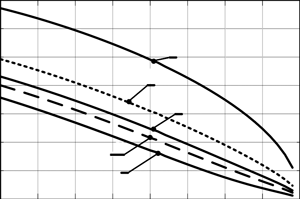Width estimation of non-Gaussian Doppler velocity spectra of meteorological formations
DOI:
https://doi.org/10.3103/S0735272721010015Keywords:
turbulence, recognition of meteorological formations, adaptive lattice filter, correlation coefficient, order of autoregression, DWRAbstract
The paper considers features of the Doppler velocity spectrum width of meteorological formations obtained on the basis of the pulse-pair method when a velocity Doppler spectrum differs from the Gaussian shape. Since the autoregressive models of various orders are widely used in practice for approximating the echo signals from meteorological formations and taking into account their spectrum shape, we have analyzed the measurement errors while using the pulse-pair method. It is shown that neglecting the information on the shape of Doppler velocity spectrum may lead to unacceptable large measurement errors and distort the true level of danger of meteorological formations. The possible methods of determining the autoregressive model orders are discussed, and the benefits of the method based on threshold processing of α-parameters of adaptive lattice filters are shown. The distribution densities of these parameters are determined for the calculation of recognition threshold of autoregressive model order. The statistical characteristics of recognition obtained by the known and proposed methods are compared. The proposed method in terms of the accuracy of order recognition actually is not inferior to the known methods, but can be implemented directly in the process of measuring the width of Doppler velocity spectrum that sets it apart from the others.
References
V. V. Naumenko, G. I. Totskii, G. I. Khlopov, O. A. Voitovich, “Classification of atmospheric formations using estimation of bicoherence of radar backscatter signals,” Radiotekhnika, no. 184, pp. 72–79, 2016, uri: https://nure.ua/wp-content/uploads/2016/Scientific_editions/184/16.pdf.
E. A. Bolelov, “Meteorological service for civil aviation: problems and ways of their solution,” Civ. Aviat. High Technol., vol. 21, no. 5, pp. 117–129, 2018, doi: https://doi.org/10.26467/2079-0619-2018-21-5-117-129.
N. V. Bocharnikov et al., Automated Meteorological Radar Complexes - Meteocell, [in Russian]. St. Petersburg: Gidrometeoizdat, 2007, uri: http://elib.rshu.ru/files_books/pdf/img-515154150.pdf.
B. M. Vovshin, I. S. Vylegzhanin, A. N. Korneev, V. V. Lavrukevich, A. A. Pushkov, “Experimental researches results of clutter properties and characteristics in impulse radars,” Uspekhi Sovrem. Radioelektroniki. Zarubezhnaya Radioelektronika, no. 2, pp. 51–68, 2018, uri: https://www.elibrary.ru/item.asp?id=32560321.
D. I. Lekhovytskiy, D. S. Rachkov, A. V. Semeniaka, D. V. Atamanskiy, A. A. Pushkov, “Estimation of Doppler velocities spectrum width of meteorological formations in coherent pulsed weather radars with arbitrary intervals of sounding,” Uspekhi Sovrem. Radioelektroniki. Zarubezhnaya Radioelektronika, no. 8, pp. 47–68, 2012, uri: https://www.elibrary.ru/item.asp?id=17997877.
D. I. Popov, “Clutter parameter estimation based on indirect algorithms,” Radioelectron. Commun. Syst., vol. 62, no. 1, pp. 42–50, 2019, doi: https://doi.org/10.3103/S0735272719010060.
V. M. Bezruk et al., “Radar recognition of meteorological objects,” in 22nd International Crimean Conference “Microwave & Telecommunication Technology,” 2012, uri: https://ieeexplore.ieee.org/document/6335877.
V. Efremov, U. Laurukevich, D. Lekhovytskiy, I. Vylegzhanin, B. Vovshin, “Results of theoretical and experimental investigations of meteorological formations power spectrum using ‘superresolution’ methods,” in Proceedings IRS 2009, 2009, pp. 777–784.
Y. I. Abramovich, N. K. Spencer, M. D. E. Turley, “Order estimation and discrimination between stationary and time-varying (TVAR) autoregressive models,” IEEE Trans. Signal Process., vol. 55, no. 6, pp. 2861–2876, 2007, doi: https://doi.org/10.1109/TSP.2007.893966.
Y. I. Abramovich, N. K. Spencer, B. A. Johnson, “Band-inverse TVAR covariance matrix estimation for adaptive detection,” IEEE Trans. Aerosp. Electron. Syst., vol. 46, no. 1, pp. 375–396, 2010, doi: https://doi.org/10.1109/TAES.2010.5417169.
E. Malikov, Y. Sun, “Semiparametric estimation and testing of smooth coefficient spatial autoregressive models,” J. Econom., vol. 199, no. 1, pp. 12–34, 2017, doi: https://doi.org/10.1016/j.jeconom.2017.02.005.
D. I. Lekhovytskiy, D. S. Rachkov, A. V. Semeniaka, “K-rank modification of adaptive lattice filter parameters,” in 2015 IEEE Radar Conference (RadarCon), 2015, vol. 2015-June, no. June, pp. 0127–0132, doi: https://doi.org/10.1109/RADAR.2015.7130983.
J. P. Burg, D. G. Luenberger, D. L. Wenger, “Estimation of structured covariance matrices,” Proc. IEEE, vol. 70, no. 9, pp. 963–974, 1982, doi: https://doi.org/10.1109/PROC.1982.12427.
D. I. Lekhovytskiy, D. S. Rachkov, A. V. Semeniaka, V. P. Ryabukha, D. V. Atamanskiy, “Adaptive lattice filters. Part I. Theory of lattice structures,” Appl. Radio Electron., vol. 10, no. 4, pp. 380–404, 2011, uri: https://openarchive.nure.ua/bitstream/document/4699/1/380-404.pdf.
D. I. Lekhovytskiy, “Adaptive lattice filters for systems of space-time processing of non-stationary Gaussian processes,” Radioelectron. Commun. Syst., vol. 61, no. 11, pp. 477–514, 2018, doi: https://doi.org/10.3103/S0735272718110018.
H.-G. Beyer, B. Sendhoff, “Simplify your covariance matrix adaptation evolution strategy,” IEEE Trans. Evol. Comput., vol. 21, no. 5, pp. 746–759, 2017, doi: https://doi.org/10.1109/TEVC.2017.2680320.
I. Stanimirović, Computation of Generalized Matrix Inverses and Applications. Apple Academic Press, 2018, uri: https://www.routledge.com/Computation-of-Generalized-Matrix-Inverses-and-Applications/Stanimirovic/p/book/9781771886222.
W.-H. Yang, S. H. Holan, C. K. Wikle, “Bayesian lattice filters for time-varying autoregression and time-frequency analysis,” Bayesian Anal., vol. 11, no. 4, pp. 977–1003, 2016, doi: https://doi.org/10.1214/15-BA978.
P. A. Bakut, I. A. Bolshakov, B. M. Gerasimov, Issues of Statistical Radio Location Theory, [in Russian]. Moscow: Sov. Radio, 1963.
I. K. Pikaev, “Estimate distribution density of complex correlation coefficient,” Radiotekhnika i Elektron., vol. 35, no. 5, pp. 1090–1094, 1990.
B. Friedlander, “Lattice filters for adaptive processing,” Proc. IEEE, vol. 70, no. 8, pp. 829–867, 1982, doi: https://doi.org/10.1109/PROC.1982.12407.


